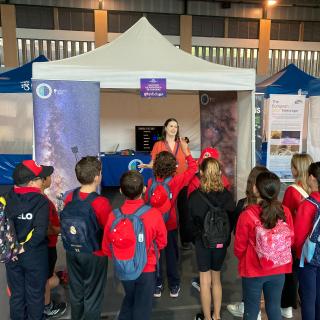It may interest you
-
 An international team, in which the Instituto de Astrofísica de Canarias participates, has succeeded in mapping for the first time the three-dimensional structure of the atmosphere of an exoplanet, that is a planet beyond the Solar System. This research, published today in Nature , has been able to discover very strong winds that carry chemical elements such as iron and titanium, which create certain weather patterns through the planet's atmosphere. This mapping opens the door to more comprehensive and detailed studies of the chemical composition and climate of other planets. Enric PalléAdvertised on
An international team, in which the Instituto de Astrofísica de Canarias participates, has succeeded in mapping for the first time the three-dimensional structure of the atmosphere of an exoplanet, that is a planet beyond the Solar System. This research, published today in Nature , has been able to discover very strong winds that carry chemical elements such as iron and titanium, which create certain weather patterns through the planet's atmosphere. This mapping opens the door to more comprehensive and detailed studies of the chemical composition and climate of other planets. Enric PalléAdvertised on -
 El Instituto de Astrofísica de Canarias (IAC) sigue afianzando su liderazgo investigador y de atracción de talento científico con el programa “ Investigadores Visitantes” de Fundación Occident. En este recién terminado año 2024, el programa cumple una década ininterrumpida de trabajo atrayendo a decenas de personas investigadoras cada año que han realizado estancias, de mínimo un mes y hasta tres meses, en el IAC. El programa permite que el personal investigador invitado comparta espacio y trabajo con miembros de los distintos grupos de investigación establecidos en el IAC, de forma que elAdvertised on
El Instituto de Astrofísica de Canarias (IAC) sigue afianzando su liderazgo investigador y de atracción de talento científico con el programa “ Investigadores Visitantes” de Fundación Occident. En este recién terminado año 2024, el programa cumple una década ininterrumpida de trabajo atrayendo a decenas de personas investigadoras cada año que han realizado estancias, de mínimo un mes y hasta tres meses, en el IAC. El programa permite que el personal investigador invitado comparta espacio y trabajo con miembros de los distintos grupos de investigación establecidos en el IAC, de forma que elAdvertised on -
 The Instituto de Astrofísica de Canarias (IAC) is once again participating in the Miniferias de la Ciencia y la Innovación en Canarias, reinforcing its commitment to popularising science and bringing astronomy closer to the Canarian public. Through its Scientific Communication and Culture Unit (UC3), the research centre is taking part in the activities organised in La Palma from 22 to 24 May. Become astro-detectives for a day Astrophysicists and popularisers Alfred Rosenberg and Alejandra Goded lead the activity ‘Astro-detectives: How do astrophysicists study the Universe?’, an interactiveAdvertised on
The Instituto de Astrofísica de Canarias (IAC) is once again participating in the Miniferias de la Ciencia y la Innovación en Canarias, reinforcing its commitment to popularising science and bringing astronomy closer to the Canarian public. Through its Scientific Communication and Culture Unit (UC3), the research centre is taking part in the activities organised in La Palma from 22 to 24 May. Become astro-detectives for a day Astrophysicists and popularisers Alfred Rosenberg and Alejandra Goded lead the activity ‘Astro-detectives: How do astrophysicists study the Universe?’, an interactiveAdvertised on
